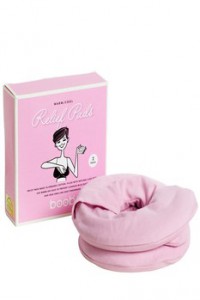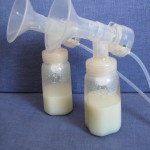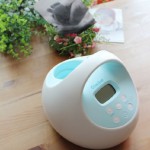
One of the more unpleasant issues that may arise while breastfeeding or pumping is getting a clogged milk duct, mastitis.
Clogged milk ducts can be painful and stubborn to get rid of but persistence pays off most of the time. In some cases, mothers may develop severe inflammation called Mastitis which is no fun at all.
Here we will go over how to know when you have a clogged duct or mastitis, what to do about it and when to seek a doctor’s help.
Before getting started it is a worth mentioning that a good breast pump is essential to help avoid clogged ducts and can actually help aid in resolving a clogged duct. If you need a pump, you can check out some of my favorites here.
Clogged Milk Duct, Mastitis – What are They?
Clogged Milk Duct
What is a clogged milk duct?

Credit: Mayo Foundation
Clogged or plugged milk duct simply means there is an obstruction in the breast that is blocking milk flow. This can happen within the nipple or further back in the breast. Some common causes of clogged milk ducts are:
- Missed feeding/pumping or inadequate removal of milk from the breast (such as bad latch, tongue tie in baby, issues with pump and suction, use of nipple shields, nipple pain, etc)
- Engorgement
- Wearing a tight or poorly fitted bra
- Pressure on the breast (such as pushing into breast when baby nurses to make room for baby to breathe, sleeping position at night, etc)
- Oversupply of milk
- Stress
- Fatigue
- Weakened Immune System
How do you know when you have a clogged milk duct?
You will typically feel a hard lump in your breast and/or have a wedge-shaped area of engorgement. It may feel tender or hot in the area where the plug is and can look red or swollen. Some moms, on the other hand, may only feel slight pain and notice nothing else.
Treatment for Clogged Milk Duct
Treatment for a clogged milk duct typically consists of a few simple steps – Warmth, Massage, Empty Breast, Repeat.

WARMTH –
- Before nursing or pumping, apply a warm, wet compress to the affected area for 15-20 minutes.
- A wet cloth will do or try heating some water then pour into a disposable diaper. This method helps the compress stay warmer longer than using just a regular cloth.
- You can also take a hot shower and let the water run over your breasts.
- Or fill a sink with warm water and submerge your breast in the water. Epsom salt can be added for better results. Throw in one cup for every 2 quarts of water.
I recommend getting a warm/cold pack like the Boob Design Warm/Cold Relief Breast Pads. They work amazingly well, are all organic, are soft, can be microwaved or cooled and have a washable cover.
You can read more about the Bood Design Warm/Cold pack, here.
MASSAGE –
- It is best to massage the affected area in combination with heat. So while you are using a warm compress, are in the shower or using the sink method, gently but firmly use your thumb to rub the plugged duct toward your nipple.
EMPTY BREAST –
- Try to nurse or pump at least every 2-3 hours when you have a clogged duct.
- Ensure you place your baby at the affected breast first when nursing. If it is too painful to start with that breast then start on the other side but switch to the affected one after your milk lets down.
- Make sure baby has a good latch and is in a position that allows you to massage the clogged duct.
- You can apply a warm compression while nursing or pumping.
- Ensure you massage the clogged duct gently but firmly toward the nipple as you nurse or pump.
- Try nursing while dangling or leaning over your baby to get gravity to help pull the clog out. You can do this by laying baby on the floor and kneeling over on all fours and nursing. Not the cutest position but quite effective.
- If you nurse first, then pump for an additional 10-15 minutes on the affected side while using the heat and massage techniques.
- You can use a cold compress between feedings to relieve pain and swelling.
AND REPEAT –
- Repeat these steps every 2-3 hours.
Mastitis
What is Mastitis?
Mastitis is an inflammation of the breast that can be caused by obstruction, infection and or allergy. Women typically have similar symptoms as they would with a clogged duct but the symptoms worsen.
The affected area may become very red and very painful and hot to the touch.
There may be red streaks extending outward from the affected area. The mother typically experiences flu-like symptoms including a high fever, chills, and headaches.
Treatment for Mastitis
An important note here is that not all cases of Mastitis are caused by infection. Mastitis again is inflammation of the breast so antibiotics are not used in every case to treat it.
If the Mother is well (not running a fever or having flu-like symptoms) and it has been less than 24 hours since the symptoms started, then try the same methods listed above for a clogged duct to clear the obstruction.
Tylenol or Ibuprofen can be taken to help with pain and reduce swelling.
 If any of the following is true, however, please contact a doctor for treatment and advice right away:
If any of the following is true, however, please contact a doctor for treatment and advice right away:
- Have flu-like symptoms and/or Fever
- It has been more than 24 hours since symptoms started and no improvement
- Mastitis in both breasts
- Red streaking develops around the affected area
- Your baby is less than 2 weeks old
- You have recently been in the hospital
- You have broken skin on or around your nipple that is showing signs of infection
- Blood or pus is present in your breast milk
If you are started on antibiotics, then it is best to also start on probiotics which help keep intestinal flora healthy and reduce the chances of a yeast infection known as Thrush.
Some Common Side Effects of Clogged Ducts and Mastitis
CLOGGED DUCTS –
- It is normal for your milk output to decrease slightly from the affected breast. This is temporary.
- Even after the milk duct has cleared you may still have some redness or tenderness (like a bruise) for several days.
- In some cases, you may pump stringy or rice grain-like clump of thickened milk. This is normal.
MASTITIS –
- Same side effects as a clogged duct
- Expressed milk may have a lumpy, stringy, clumpy, or gelatin-like texture. This milk should be fine for baby. The clumps may make bottle feeding a challenge as it can clog the nipple, so you can strain the milk.
- Milk may contain pus, blood or mucus.
It is always best to consult with your doctor on any issues you may be experiencing. Mastitis can be dangerous and make you very sick if you develop an infection, so ensure you get medical treatment right away.
In the end, a clogged duct is typically easy to deal with and most resolve without issue.
Have any techniques you want to share that have worked for you in the past? Leave a comment and tell us about your experience!
Next Up – How To Increase Your Milk Supply After Having a Clogged Milk Duct or Mastitis – Read Now—->
Also See –
Pin it For Later!




